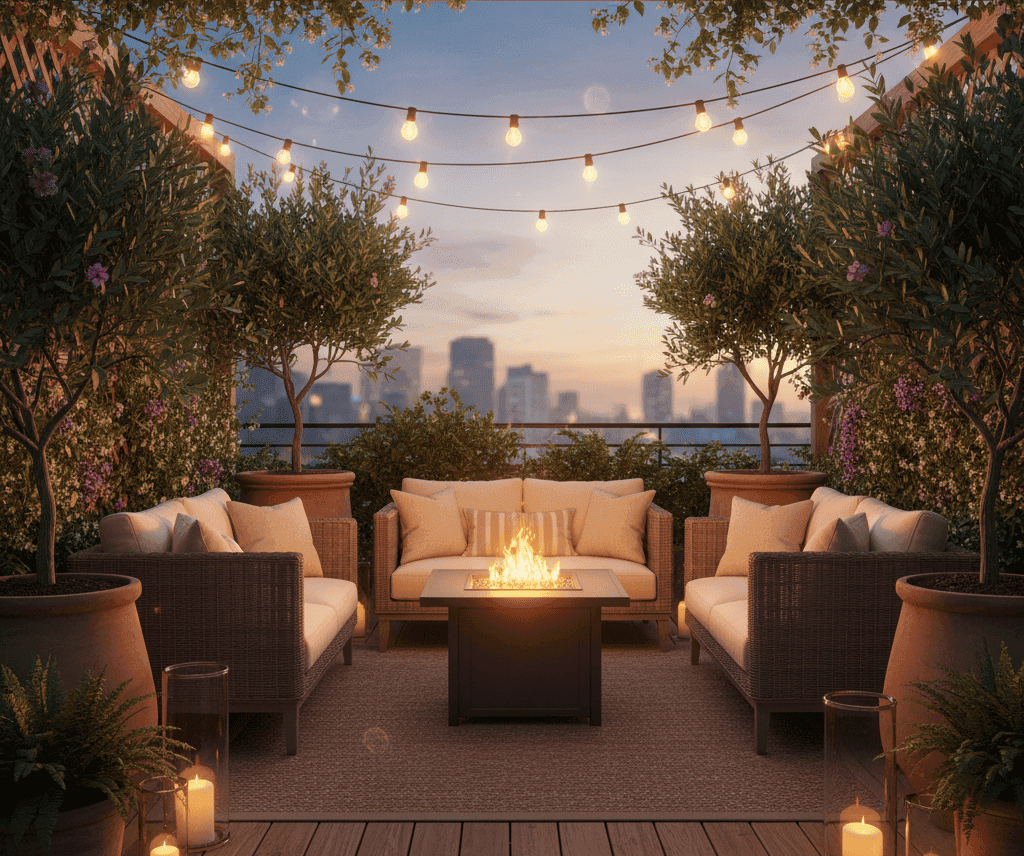7 Bold Ways to Elevate Outdoor Living
I’ve always believed outdoor living isn’t just about dragging a chair onto a deck. It’s about deciding that the air, the sky, the smell of rain on wood — all of it — is part of your daily architecture. You stop treating the terrace like a waiting room for summer barbeques. You start treating it like a room with its own soul.
And once you flip that switch, every design choice feels urgent. Material underfoot, light above, walls or no walls, the flow into your house — it all starts mattering.
1. Anchor the space like a real room
A terrace floats until you pin it down. Rugs help, but I’d go further. Drop in something heavy, something that says “this is a room.” A chunky table, a brutal sculpture, even a fire bowl. The same way a modern kitchen has that one slab of marble anchoring everything, an outdoor living zone needs its anchor.
Boundaries are psychology. You want to step out the door and feel you’ve entered somewhere new, not half-in, half-out.
2. Define edges with texture
If you can’t build walls, let textures do the work. Rough brick at one edge, smooth decking at another. Grass creeping in deliberately, not by accident. When your bare feet tell you, “I crossed a line,” your brain relaxes.
Simple list of material ideas that define edges:
- Polished stone border
- Warm cedar decking
- Gravel perimeter strip
- Low planter boxes
3. Storage is not a luxury
People forget storage outdoors. Then they end up with cushions stuffed into garages, tools leaning like exiles against the wall. Built-in benches with hidden storage change the game. It’s the same thinking as hidden storage in tiny kitchens: make space do double duty.
A bench that eats clutter makes a terrace feel like a permanent space, not a pop-up.
4. Furniture must be multipurpose
The indoor/outdoor line is thin. Pick multipurpose pieces that forgive weather and still look human indoors if you drag them back. That’s where outdoor design mirrors the logic of a studio workspace — you want flexibility, you want zones that shift when you need them.
A folding chair that feels sculptural, a table with detachable trays, a hammock that doubles as visual art when empty. That’s the vibe.
Quick comparison table:
| Piece | Outdoor Role | Indoor Role |
|---|---|---|
| Folding teak table | Dining | Console against a wall |
| Canvas sling chair | Lounge | Bedroom corner seat |
| Low planter box | Divider | Storage bin |
| Rolling cart | Bar station | Kitchen helper |
5. Play with sound and silence
Cities are noisy. Suburbs too. Terraces are exposed to both. Studios are noise traps — and terraces can be the same. You need defense. Heavy rugs, foliage walls, maybe even soundproof curtains. Borrow the logic of acoustic design from interiors. Some people go wild and add glass partitions. And here’s where the INSERT comes in: Здесь прекрасно подойдут outdoor living with glass walls, которые защищают от ветра, но оставляют вид.
Silence is underrated. It’s not only about comfort; it’s about focus. A quiet terrace feels like sanctuary, not an afterthought. Even the smallest effort counts — a row of dense evergreens, a bamboo screen that whispers instead of rattling.
Quick fixes for sound control:
- Rugs & mats: absorb footsteps, reduce echoes.
- Green walls: double as privacy screens.
- Outdoor curtains: soften both sound and wind.
- Water features: add white noise that masks the city.
| Method | Cost | Effectiveness | Extra benefit |
|---|---|---|---|
| Heavy fabric curtains | $$ | Medium | Adds softness visually |
| Tall shrubs or hedges | $$$ | High | Natural, seasonal change |
| Fountains / water walls | $$$ | Medium | Adds ambiance |
| Glass partitions | $$$$ | Very high | Keeps views intact |
Sometimes it’s not about killing every sound — it’s about shaping what you hear. Birds, leaves, water: good. Cars, horns, barking: not so good.
6. Light is everything
Too many terraces glow like interrogation rooms or sit black as caves. Treat it like theater instead. Layers: strings of dimmable bulbs, a focused spotlight on one wall, hidden strips under benches.
It’s no different than a bathroom retreat layered with ambient and task lights. You create hierarchy. One pool of light to talk in, another glow to just remind you the corner exists. Without that, the terrace dies after sunset.
But don’t just throw fairy lights everywhere. Think in levels — top, middle, bottom. Overhead light feels open but harsh. Table lamps feel human, intimate. Ground-level light outlines space, makes it safer too.
Three layers of terrace lighting:
- Overhead glow: string lights, lanterns, pergola fixtures.
- Eye-level mood: wall sconces, portable lamps, candle clusters.
- Ground accents: recessed floor spots, step lights, path markers.
| Lighting type | Energy use | Mood created | Best use |
|---|---|---|---|
| LED strips | Low | Futuristic, clean | Under benches / rails |
| Lanterns | Medium | Warm, nostalgic | Corners, tables |
| Flood spots | High | Dramatic, harsh | Highlight one feature wall |
| String bulbs | Low | Casual, playful | Across beams / wires |
Light can turn a terrace into a second living room after dark. Or it can ruin it completely. Balance is the trick.
7. Bring digital calm outside
Sometimes, outdoor living merges with our tech-addled lives. Streaming movies under the sky. Remote work from the deck. Even posting decor photos online. Ironic, yes, but also real. That’s why layouts inspired by website templates aren’t irrelevant here: clean structure, modular blocks, responsive flow. It’s the same mental model.
Your terrace is a grid. Assign each block a function — lounge, dine, work, plants. Keep it modular so you can shift it next year without starting over.
Table: Functional blocks in outdoor living
| Block | Size | Function | Material Hint |
|---|---|---|---|
| Lounge zone | 2×3m | Relax | Low couches, cushions |
| Dining zone | 3×3m | Eat & gather | Wood table, metal chairs |
| Green strip | 1×6m | Plants | Raised beds, gravel |
| Work corner | 2×2m | Laptop, coffee | Compact desk, shade screen |
8. Emotional connection
This part’s slippery. You can measure storage or calculate sunlight angles, but you can’t quantify what makes a terrace feel alive. Some designers talk about “emotional connection.” They’re right.
I think it’s the small things. The smell of cedar after rain. A string of lights you hang every spring with your kids. The rough edge of a planter box you built yourself. None of this is on the sales sheet. But it’s what makes you choose the terrace over the couch on a tired evening.
Signs your terrace has emotional pull:
- You go out there without planning to.
- Guests drift outside without invitation.
- You keep a blanket handy even in cold months.
- It feels wrong to not water the plants.
| Element | Why it matters | Emotional trigger |
|---|---|---|
| Personal DIY build | Shows your effort | Pride, ownership |
| Seasonal rituals | Repeat each year | Nostalgia |
| Scents (cedar, herbs) | Tied to memory | Calm, comfort |
| Imperfections | Signs of life | Authenticity |
Maybe that’s the lesson: don’t chase perfection. Chase the moment you want to be out there even when the weather isn’t perfect. That’s when outdoor living becomes real living.
9. Trend waves vs personal stubbornness
Trends matter — you’ll see them spill over from trade shows and glossy reports, like those home decor trends flooding design calendars. But the truth? Your terrace doesn’t care what’s hot. It cares whether you use it.
Sure, pick up a seasonal color or two. Maybe copy the textile of the year. But build the bones stubbornly. Don’t chase every market preview. The anchor table, the layout, the storage — these things don’t age.
10. From terrace to ritual
At the end, what you’re really building isn’t furniture on a slab. It’s ritual. Morning coffee outside. Evening wine. Family dinners that last too long. A terrace that isn’t ritual is just wasted square meters.
Ritual doesn’t appear automatically. You need to design for it. A bench where the sun hits exactly at 8 a.m. A dining spot that feels private enough to laugh too loud. A fire pit that becomes a magnet for conversations.
Common terrace rituals people build around:
- Morning reset: coffee, reading, stretching.
- Evening slow down: drinks, family chat.
- Weekend meals: brunch or barbecue.
- Seasonal traditions: lights in winter, herbs in spring.
| Ritual | Needed design element | Result |
|---|---|---|
| Morning coffee | East-facing chair | Calm start, routine |
| Family dinners | Large communal table | Togetherness |
| Night talks | Fire pit or lantern cluster | Intimacy, warmth |
| Solo reset | Hammock or lounge chair | Reflection, rest |

FAQ
Q1: How do I make a small terrace feel larger?
Use light finishes, mirrors on adjacent walls, and keep furniture low-profile. Define zones with rugs instead of bulky partitions.
Q2: What outdoor materials last the longest?
Teak, cedar, powder-coated steel, and stone. Fabrics should be UV-resistant and water-repellent.
Q3: Can I design a terrace to double as a workspace?
Yes. Integrate a small desk zone, shade with a folding screen, and add power access. Keep it flexible so it vanishes when not in use.
Q4: Do I need professional help or can I DIY?
DIY is possible for storage benches, lighting, and layout tweaks. For structural changes — like roofing or glass walls — professional consultation saves money in the long run.
